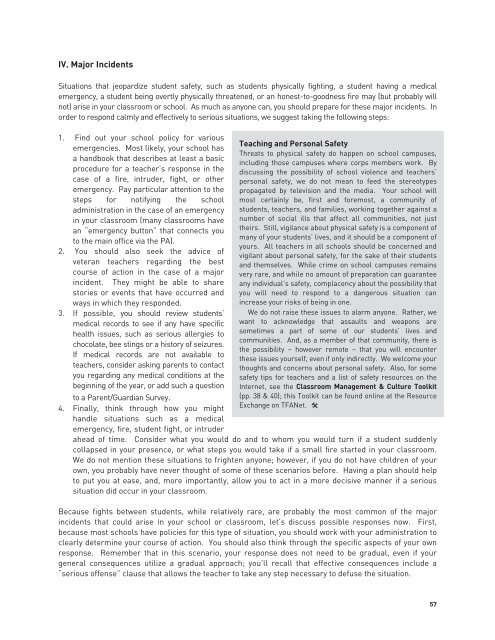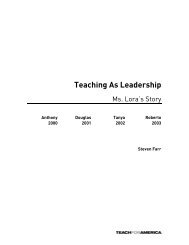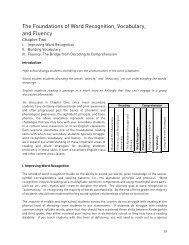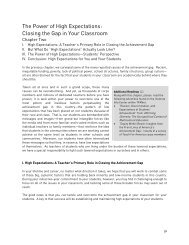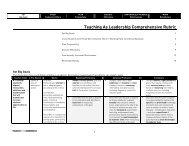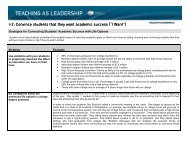Responding to Misbehavior - Teaching As Leadership
Responding to Misbehavior - Teaching As Leadership
Responding to Misbehavior - Teaching As Leadership
You also want an ePaper? Increase the reach of your titles
YUMPU automatically turns print PDFs into web optimized ePapers that Google loves.
IV. Major Incidents<br />
Situations that jeopardize student safety, such as students physically fighting, a student having a medical<br />
emergency, a student being overtly physically threatened, or an honest-<strong>to</strong>-goodness fire may (but probably will<br />
not) arise in your classroom or school. <strong>As</strong> much as anyone can, you should prepare for these major incidents. In<br />
order <strong>to</strong> respond calmly and effectively <strong>to</strong> serious situations, we suggest taking the following steps:<br />
1. Find out your school policy for various<br />
emergencies. Most likely, your school has<br />
a handbook that describes at least a basic<br />
procedure for a teacher’s response in the<br />
case of a fire, intruder, fight, or other<br />
emergency. Pay particular attention <strong>to</strong> the<br />
steps for notifying the school<br />
administration in the case of an emergency<br />
in your classroom (many classrooms have<br />
an “emergency but<strong>to</strong>n” that connects you<br />
<strong>to</strong> the main office via the PA).<br />
2. You should also seek the advice of<br />
veteran teachers regarding the best<br />
course of action in the case of a major<br />
incident. They might be able <strong>to</strong> share<br />
s<strong>to</strong>ries or events that have occurred and<br />
ways in which they responded.<br />
3. If possible, you should review students’<br />
medical records <strong>to</strong> see if any have specific<br />
health issues, such as serious allergies <strong>to</strong><br />
chocolate, bee stings or a his<strong>to</strong>ry of seizures.<br />
If medical records are not available <strong>to</strong><br />
teachers, consider asking parents <strong>to</strong> contact<br />
you regarding any medical conditions at the<br />
beginning of the year, or add such a question<br />
<strong>to</strong> a Parent/Guardian Survey.<br />
4. Finally, think through how you might<br />
handle situations such as a medical<br />
emergency, fire, student fight, or intruder<br />
<strong>Teaching</strong> and Personal Safety<br />
Threats <strong>to</strong> physical safety do happen on school campuses,<br />
including those campuses where corps members work. By<br />
discussing the possibility of school violence and teachers’<br />
personal safety, we do not mean <strong>to</strong> feed the stereotypes<br />
propagated by television and the media. Your school will<br />
most certainly be, first and foremost, a community of<br />
students, teachers, and families, working <strong>to</strong>gether against a<br />
number of social ills that affect all communities, not just<br />
theirs. Still, vigilance about physical safety is a component of<br />
many of your students’ lives, and it should be a component of<br />
yours. All teachers in all schools should be concerned and<br />
vigilant about personal safety, for the sake of their students<br />
and themselves. While crime on school campuses remains<br />
very rare, and while no amount of preparation can guarantee<br />
any individual’s safety, complacency about the possibility that<br />
you will need <strong>to</strong> respond <strong>to</strong> a dangerous situation can<br />
increase your risks of being in one.<br />
We do not raise these issues <strong>to</strong> alarm anyone. Rather, we<br />
want <strong>to</strong> acknowledge that assaults and weapons are<br />
sometimes a part of some of our students’ lives and<br />
communities. And, as a member of that community, there is<br />
the possibility – however remote – that you will encounter<br />
these issues yourself, even if only indirectly. We welcome your<br />
thoughts and concerns about personal safety. Also, for some<br />
safety tips for teachers and a list of safety resources on the<br />
Internet, see the Classroom Management & Culture Toolkit<br />
(pp. 38 & 40); this Toolkit can be found online at the Resource<br />
Exchange on TFANet. <br />
ahead of time. Consider what you would do and <strong>to</strong> whom you would turn if a student suddenly<br />
collapsed in your presence, or what steps you would take if a small fire started in your classroom.<br />
We do not mention these situations <strong>to</strong> frighten anyone; however, if you do not have children of your<br />
own, you probably have never thought of some of these scenarios before. Having a plan should help<br />
<strong>to</strong> put you at ease, and, more importantly, allow you <strong>to</strong> act in a more decisive manner if a serious<br />
situation did occur in your classroom.<br />
Because fights between students, while relatively rare, are probably the most common of the major<br />
incidents that could arise in your school or classroom, let’s discuss possible responses now. First,<br />
because most schools have policies for this type of situation, you should work with your administration <strong>to</strong><br />
clearly determine your course of action. You should also think through the specific aspects of your own<br />
response. Remember that in this scenario, your response does not need <strong>to</strong> be gradual, even if your<br />
general consequences utilize a gradual approach; you’ll recall that effective consequences include a<br />
“serious offense” clause that allows the teacher <strong>to</strong> take any step necessary <strong>to</strong> defuse the situation.<br />
57


